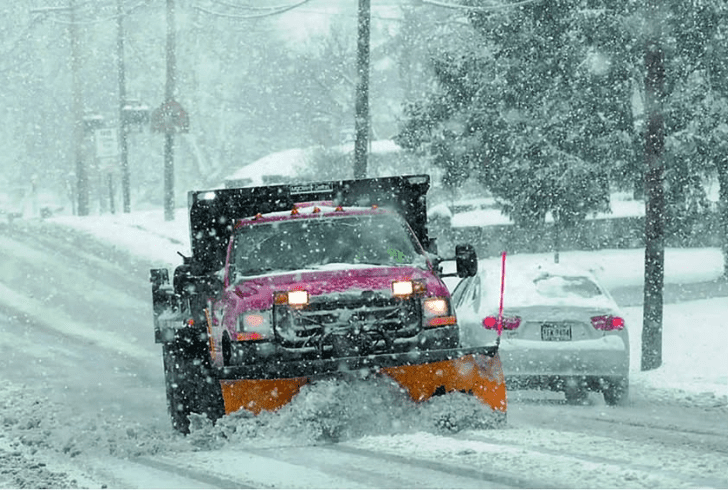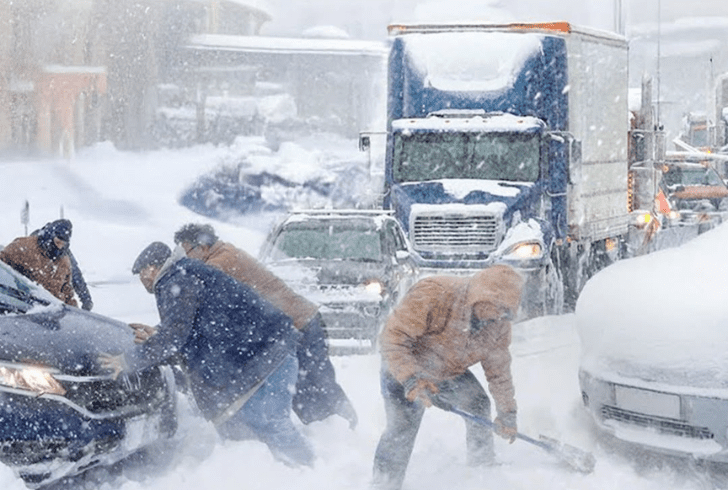A powerful winter storm is moving across the Mid-Atlantic, delivering heavy snow, icy conditions, and significant travel disruptions. This system is expected to bring a combination of snowfall, freezing temperatures, and hazardous road conditions, affecting millions across the central and eastern U.S. The National Weather Service has issued warnings for severe weather conditions, urging residents to stay cautious and prepare for potential challenges.
Most Impacted Areas by the Winter Storm
The storm has heavily impacted parts of West Virginia, Maryland, Virginia, Delaware, and Washington, D.C., causing disruptions to daily life. These regions are experiencing heavy snow accumulations and dangerously low temperatures, making travel treacherous.
Kansas has already reported severe snowfalls, with Chapman receiving up to 18 inches of snow. Additionally, icy roads have become a significant hazard across Indiana, Missouri, and western Nebraska, disrupting essential services and travel routes.
Forecasted Snowfall and Temperatures

Instagram | cityofmartinsburg_wv | Due to the winter storm, daily life in Washington, DC faces significant disruptions.
According to the National Weather Service, the storm is expected to deliver 6–12 inches of snow across the Mid-Atlantic region, with 2–4 additional inches falling in parts of the Ohio Valley and Central Appalachians.
After the snow, temperatures are predicted to plunge further, creating more challenges for affected areas.
1. Nighttime Lows - Across the Central Plains, Mississippi, and Ohio Valleys, temperatures will drop into single digits or near zero, particularly in areas with deep snowpacks.
2. Daytime Highs - Even during the day, many areas will struggle to rise above freezing. In some regions, highs will remain in the teens.
3. Mid-Atlantic - Temperatures here are expected to dip into the teens overnight, with daytime highs barely reaching freezing.
Travel Disruptions Caused by the Storm
Travel across the affected regions has been severely impacted by the storm. Roads, airports, and rail systems deal with delays and cancellations.
Road Conditions
Major highways and roadways in states like Kansas, Missouri, and Indiana have become dangerous due to snow and ice accumulation. Emergency crews continue to clear roads, but drivers are urged to remain vigilant and avoid unnecessary travel.
Flight Delays and Cancellations
Air travel has also been disrupted, particularly near Washington, D.C. Over 800 flights were canceled or delayed at Reagan National Airport and Dulles International Airport, creating significant challenges for passengers. Tracking platforms like FlightAware.com have reported widespread delays nationwide as airlines struggle to manage the ongoing weather conditions.
Power Outages
The winter storm has left approximately 330,000 customers without electricity, particularly in Missouri, Illinois, Indiana, Kentucky, and West Virginia. Utility crews are working to restore power, but the cold weather has made recovery efforts more challenging.
Impact on Schools and Businesses
School closures and disruptions to business operations have become widespread in response to the severe weather. For instance, many schools across the affected states have announced closures or moved to remote learning to ensure the safety of students and staff.
Similarly, businesses in key regions are also facing challenges due to icy conditions and low temperatures. Employees and customers are encouraged to stay indoors and monitor local updates for any changes in the storm's path.
Safety Precautions During the Storm
As the storm continues to bring hazardous conditions, safety remains a top priority. Authorities have advised residents to follow these precautions:
1. Stay Informed - Regularly check weather updates and warnings issued by local authorities.
2. Avoid Non-Essential Travel - Roads may become impassable due to snow and ice, so staying off the roads can help prevent accidents.
3. Prepare for Power Outages - Keep flashlights, batteries, and warm blankets handy in case of prolonged power disruptions.
4. Dress Appropriately - Wear layers to stay warm in freezing temperatures. Limit time spent outdoors to avoid hypothermia or frostbite.
Government and Local Efforts to Address the Winter Storm

Instagram | thepagez | Despite challenges, teams work hard to manage the winter storm in Washington, DC.
The Biden administration is actively monitoring the storm and working with state and local governments to coordinate relief efforts. White House spokesperson Jeremy Edwards emphasized the importance of taking precautions, stating, “All Americans affected by this weather should take it seriously, continue to monitor forecasts, and heed the warnings of local officials.”
Emergency response teams across affected states are working tirelessly to ensure public safety. Snowplows, utility crews, and first responders have been deployed to assist with road clearing, power restoration, and other critical services.
How the Winter Storm Impacts Communities
The storm’s effects extend beyond travel and weather challenges, significantly impacting daily life in affected regions. Communities are coming together to support one another during this difficult time. Shelters have been set up to help residents without power or heat, while local organizations provide food and supplies to those in need.
At the same time, the weather is creating opportunities for neighbors to connect and assist each other. Acts of kindness, like helping to shovel snow or providing warm meals, remind people of the resilience and strength found in community support.